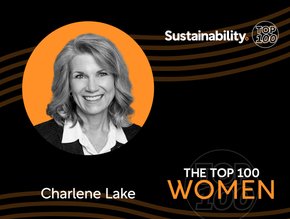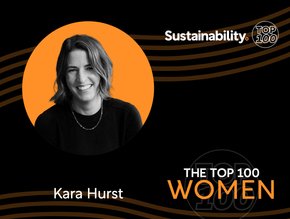The business case for tackling the microplastics crisis

Add microplastics to the agenda or we leave footprints not handprints on our food chain.
The sustainability sector is growing at an exponential rate. Yet as quickly as progress is made on one sustainability or environmental issue, another rears its head.
The next challenge to deal with is the toughest one yet, and we have been living with it without realising that it has become a global crisis - microplastic pollution.
Latest findings from a group of scientists spanning the Arctic have shown that snow from this pristine, remote location has been contaminated with plastic particles which are visible in ice cores drilled two metres into the surface.
Closer to home, a recent study has indicated that microplastics, which are plastics smaller than 5 mm in length, appear in 90% of all bottled water and 81% of the world’s tap water.
Microplastic in the ocean can enter the food chain and end up on our plates and in the stomachs of our children. This isn’t only an ocean conservation issue, but an imperative to address to protect human health. It needs to be not only on every sustainable business agenda, but ingrained within the culture of each company.
What is the effect, and should we be worried?
At this stage, the area is so new that studies on the full effect of the toxins within microplastics on the human body haven’t been completed.
However, the World Health Organisation (WHO) saw fit to urgently launch an investigation last year when it recognised that microplastics had entered the food chain and our bodies. Its findings so far conclude that more investigation is needed.
There is even widespread concern that fragments are small enough to pass through the lining of the stomach wall and enter into the bloodstream. A study in 2015, found that microplastic particles are already able to move through the gut wall of sea animals into other tissues.
Given that the raw materials for the creation of commonly used plastics are derived from crude oil and natural gas, if these materials get into the bloodstream it could be catastrophic to human health.
Why should businesses be concerned? And where does it fit?
Around 300mn tonnes of plastic are produced globally each year. Much of it is created for consumer purposes. As these plastics break down into smaller and smaller particles, the businesses that create them, whether due to consumer demand or not, have an opportunity to turn the tide and change their methodology as part of a wide ranging sustainability agenda.
In the past, this business sustainability agenda has been split into six points by Dr Neil Drobny:
1. The Sharing Economy
2. Positioning a product as a service to encourage creation of longer life products
3. The circular economy to reuse waste
4. ‘Handprints’ that leave positive change and ‘footprints’ that leave a negative impact
5. Quadruple bottom line (people, planet, profit, purpose)
6. Voluntary transparency to demonstrate sustainability and best practice
The journey of plastic to microplastic particles touches on all of these areas. From a sharing economy that reuses rather than throws away, to transparent policies on how waste is dealt with, the manner in which microplastics are entwined into each of these points proves that tackling the microplastic problem is a matter of changing the culture of an organisation, not just the agenda.
This is an issue that isn’t isolated to one area of the planet, it affects us all. Nonetheless, by challenging the microplastic problem head on and altering the culture of business, we can affect change and leave ‘handprints’ rather than ‘footprints’ on the earth’s water, food and animals.
SEE ALSO:
What’s the benefit to business?
We set up the Water Smart Foundation to protect and cleanse our most precious resource and give access to clean, healthy and non-polluted drinking water to all.
As part of the plan, our environmental experts offer sustainability solutions and technology to shrink the carbon footprint and the plastic waste from a business. This is done with a business focus that can reap rewards.
One of the ways we do this is to install a water fountain from our technology partner at no up front cost. This fountain has unique and patented treatment technology that takes water from source and removes microplastics and other harmful pollutants to produce water that is rich in alkaline minerals and anti-oxidants and is the purest, healthiest, best tasting water available. By encouraging refills, this removes plastic water bottles from your supply chain and offers a solution that is both cost and carbon effective, leaving the handprints that we want to leave.
The resulting alkaline water is called Pure Ionic Water, for which the business is only charged a small literage cost which goes towards running costs and the Water Smart Foundation. Hospitality and restaurants have the opportunity to charge customers for this super-premium water giving a tangible benefit of an estimated £200,000 a year, based on 50,000 sales per annum.
For corporates that engage with the Water Smart Foundation and make it part of their culture rather than a donated to cause, the benefits are not just leaving handprints over footprints. There is proof that there are profits to be made.
How does water sustainability sell?
Etched into the mind of the consumer is the image of a whale carrying around its dead offspring on Blue Planet. As a result, the thirst for sustainable answers to take better care of our planet, and the awareness that plastic has polluted our oceans to devastating effect has never been more intense.
Consumers are desperate to see action from the businesses they buy from. One study found 88% of consumers are more loyal to a company that supports social or environmental issues and it has been found that 67% of consumers in Europe and 90% of consumers in Latin America are very concerned about water pollution.
This is an opportunity for any company to build affinity with consumers if it makes cleansing our water supply part of the way it exists.
Of course, when trade wars rage and borders tighten, the investment needed to change is still substantial and considered a risk at a time when economic challenges persist. But the latest iteration of the CDP’s Climate A list, which grades companies on promoting low-carbon outputs, reveals that its best performing organisations are producing 6% higher returns on average compared to other brands.
Meanwhile Unilever has just announced that the group’s 26 Sustainable Living brands (including Dove, Lipton, Hellmann’s and Seventh Generation) grew 46% faster than the rest of the business and delivered 70% of its “turnover growth.” 22 of Unilever’s 26 Sustainable Living brands are in its top 40 brands. These sustainable strategies are helping to fuel commercial success.
How can we leave handprints in our water and food, not footprints?
We are not pretending that this is an easy task. Making change to raise awareness of microplastics polluting the water supply and our food chain is a strand to the sustainability agenda that covers the complete breadth of the existing approach. It sits in each of six brackets neatly outlined and demands consideration at each turn.
However, with the issue already being a crisis demanding reversal and not prevention, the need is dire for this to become part of what we do, rather than just what we support.
We need businesses, governments and consumers to come together, join us and work with a one team philosophy to become part of a strategic culture that works for business as well as the planet.
With the microplastics crisis it is undoubted that we need everyone pulling in the same direction to affect real change. As sustainability experts with a desire to give clean, microplastic free water to all, now is the time to make microplastics part of the sustainability agenda and our culture one of leaving handprints not footprints in our water and on our food chain.
- Energy efficiency can help meet the world’s thirst for waterSustainability
- Under the microscope: test beds for smart city technologiesSustainability
- Xylem on how to help utilities meet science-based targetsSustainability
- Man City and Xylem – united in call for 'water heroes'Sustainability






